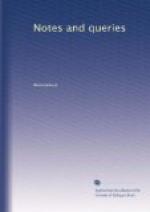“Qui quidem Richardus
Episcopus postea translatus fuit ad
Episcopatum Dunelmensem ...
Incipit Prologus in Philobiblon
Richardi Dunelmensis Episcopi,
quem librum compilavit Robertus
Holcot de Ord. Praedicatorum
sub nomine dicti Episcopi.”
Still, however, in the appendix to vol. iv. of the Itinerary, p. 164., it is said:—
“Richardus de Bury,
alias Angravyle dictus, episc. Dunelm.,
scripsit Philobiblon.”
Upon Leland’s authority, the Bodleian catalogue ascribes the work in question to Robertus Holcot. Watt, however (Bibl. Brit.), seems to imagine R. de Bury and Holcot to be the same person. His words are (vol. i. c. 176 ):—“Bury, Richard. Dunelm., alias Robertus Holcot, Bishop of Durham, and Chancellor and Treasurer of England, in the reign of Edward III.;” and again, under Holcot’s name, “Holcot, Robert, or Richard D. Bury.”
The translator (J.B. Inglis) distinguishes in his Preface between these contemporary writers, and considers R. de Bury to be the undoubted author of this work passing under his name. In corroboration of his opinion, Mr. Inglis refers to the Biographical and Retrospective Miscellany; and, in order to prove that the work was finished in the author’s lifetime, he produces the words:
“Quod opus (Philobiblon)
Aucklandiae in habitatione sua
complevit, 24 die Januarii,
anno a communis salutis origine
1344, aetatis suae 58, et
11 suae pontificatus.”
and then adds:
“He died 14 April, 1345. Holcot died in 1349.”
There appears to be some confusion about the editions, also, of the Philobiblon. There is an edition, 4to. Par., apud Gaspar. Philippum, 1500; also edit. secund. 4to. Oxoniae, 1598; and it is printed in the Philolog. Epist. ex Bibl. Melch. Goldasti, ed. Lipsiae, 1674. But prior to all these is the edition “printed at Cologne, 1473,” from which the translation is made, and which is described by Watt as “the editio princeps, and a work of uncommon rarity.”
Query. Why does the Oxford edition of 1598 call itself “editio secundo?” If the Paris edit. of 1500 so far differ from that of 1473 as to entitle it to be considered a different work, had the second MS. passed through Holcot’s hands?
J. SANSOM.
The translation of Richard de Bury’s Philobiblon, by Mr. Inglis, printed in 1832 for the late Mr. Rodd, is an unsatisfactory performance. The version is bald and spiritless, and some of the best passages of the original are rendered in language that does no justice to the author’s meaning. His style is so peculiar, so allusive, and so full of metaphor and quotation, and the work is luminous with “the sparks of so many sciences,” that a good translation is a desideratum.




